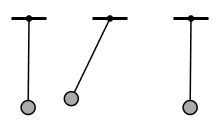Day 24 - Driven Oscillations#

Resonance in a driven pendulum system. \(\longrightarrow\)
Source: Wikipedia
Announcements#
Midterm 1 is still being graded (sorry, bit off more than I can chew)
Homework 6 is due Friday
Homework 7 is posted, due next Friday
Final project check-in #1
Friday’s Class: We will complete HW 6 Exercises 2 and 4 together.
Seminars this week#
TUESDAY, October 21, 2025#
Theory Seminar, 11:00am., FRIB 1200 lab, In person and online via Zoom Speaker: Antonio Bjelcic, LLNL Title: Small and Large Amplitude Collective Dynamics within Nuclear Density Functional Theory Zoom Link: 964 7281 4717 Meeting ID: 48824
Seminars this week#
WEDNESDAY, October 22, 2025#
FRIB Nuclear Science Seminar, 3:30pm., FRIB 1300 Auditorium and online via Zoom Speaker: Dr. Nan Liu of Boston University Title: Presolar Grains as Probes of Type II Supernova Nucleosynthesis Please click the link below to join the webinar: Join Zoom Meeting: https://msu.zoom.us/j/93944167137?pwd=jzvwvbL8YqDnJNpzDPat8IHcrFdtC5.1 Meeting ID: 939 4416 7137 Passcode: 239049
Seminars this week#
THURSDAY, October 23, 2025#
Colloquium, 3:30 pm, 1415 BPS, in person and zoom. Host ~ Refreshments and social half-hour in BPS 1400 starting at 3 pm Speaker: Darryl Seligman, MSU Title: Divergent Small Bodies: Interstellar Interlopers and Dark Comets Zoom Link: https://msu.zoom.us/j/94951062663 Password: 2002 Or complete link: https://msu.zoom.us/j/94951062663?pwd=c48uM25P9UsRVuR74rkOioOWgpoxgC.1
Seminars this week#
FRIDAY, October 24, 2025#
QuIC Seminar, 12:30pm, -1:30pm, 1300 BPS, Virtual only today Speaker: James Whitefield, Dartmouth Title: TBA Full Schedule is at: https://sites.google.com/msu.edu/quic-seminar/
Seminars this week#
FRIDAY, October 24, 2025#
IReNA Online Seminar, 2:00 pm, In Person and Zoom, FRIB 2025 Nuclear Conference Room, Light refreshments will be served at 1:50pm. Hosted by: Hosted by: Linda Lombardo (INAF Trieste) Speaker: Marta Molero, TU Darmstadt Title: Chemical evolution of neutron-capture elements: a multi-objective approach Zoom Link: https://msu.zoom.us/j/827950260 Password: JINA
Reminders#
We solved the damped harmonic oscillator equation:
We chose a solution (ansatz) of the form
and computed the roots of the characteristic equation:
We found the roots to be:
Weak Damping#
We found that when \(\beta^2 < \omega_0^2\), the roots are complex:
This means that the solution is oscillatory:
The solution is a damped oscillation with frequency \(\omega_1 = \sqrt{\omega_0^2 - \beta^2}\).
Strong Damping#
When \(\beta^2 > \omega_0^2\), the roots are real:
This means that the solution is not oscillatory: $\(x(t) = C_1 e^{r_1 t} + C_2 e^{r_2 t}\)\( where \)r_1 = -\beta + \sqrt{\beta^2 - \omega_0^2} < 0\( and \)r_2 = -\beta - \sqrt{\beta^2 - \omega_0^2} < 0$.
The solution is the sum of two exponentials with different decay rates.
Critical Damping#
When \(\beta^2 = \omega_0^2\), the roots are real and equal (repeated roots): $\(r = -\beta\)$
This means that the solution is not oscillatory, but also that our ansatz is not sufficient. The correct form of the solution is:
In most cases, we will work with weak damping.
Clicker Question 24-1#
How are you doing?
Semester is going well; I’m locked in.
Semester is going alright; Tough but I’m working on it.
Semester is not going great TBH; I need to make some changes.
Danny, this semester is some BS.
Clicker Question 24-2#
What do we expect the phase space diagram (\(x\) vs \(\dot{x}\)) to look like for a weakly damped harmonic oscillator?
A set of ellipses
A set of spirals
Depends on how weak the damping is
Depends on the total energy
More than one of the above
Clicker Question 24-3#
The driven harmonic oscillator equation is:
with \(w_0^2 = k/m\) and \(2\beta = b/m\). What is the dimension of the driving force \(f(t)\)?
Force (Newtons, N)
Force per unit second (N/s)
Force per unit length (N/m)
Force per unit mass (N/kg)
Clicker Question 24-4#
The driven harmonic oscillator equation is:
This ODE is a ________ differential equation.
linear
nonlinear
first-order
second-order
more than one of the above
Example: Sinusoidal Driving Force#
Let \(f(t) = f_0 \cos(\omega t)\), so that the driven harmonic oscillator equation is:
Note: \(\omega \neq \omega_0\)
Note that if the driving follows a sine wave, then we have:
Interesting, \(e^{i \omega t} = \cos(\omega t) + i \sin(\omega t)\), let try to work with \(z(t) = x(t) + i y(t).\)
Clicker Question 24-5#
We found that the square amplitude of the driven harmonic oscillator is:
When is the amplitude of the driven oscillator maximized?
When the driving frequency (\(\omega\)) is far from the natural frequency (\(\omega_0\))
When the driving frequency (\(\omega\)) is close to the natural frequency (\(\omega_0\))
When the damping (\(2\beta\)) is weak
When the damping (\(2\beta\)) is strong
Some combination of the above
